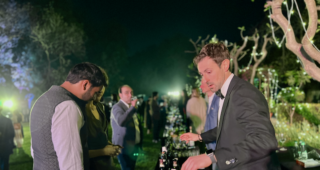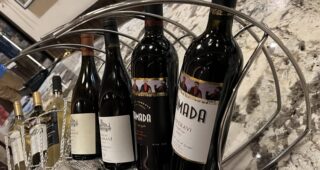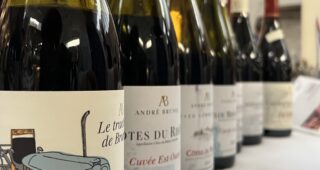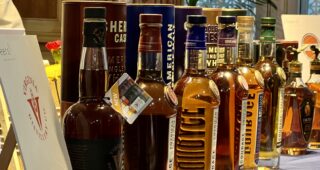Some wine tastings are more equal than others and a tasting of Bordeaux Grands Crus wines definitely falls under this category. Aficionados will know that the 1855 classification of top French wines initiated by King Napoleon III is still the synonym for the best wines of the world, though much water has flown down the Gironde ever since the classification was made.
The classification, restricted to the Médoc and Graves region of Bordeaux has a total of 62 estates across 5 subclassifications stretching across Premier (first) to Cinquième (fifth) growths . These are the wines that are long lived, full of character and quite understandably produced under the most stringent of Appellation regulations .
This March, I had the good fortune of attending a vertical tasting cum dinner of one such prestigious estate which is also identified with its old Indian connection . This connection manifests in the form of India pagodas and an elephant logo that make the estate property quite distinctive. Yes, I am talking of Chateau Cos d’Estournel the famed St Estephe deuxième (second) growth.

The tasting was organised under the aegis of FICOFI, a niche fine wines and services organization headquartered at Paris. Aymeric de Gironde, the General Manager Cos d’Estournel and Cecily Burchett-Chambers, Business Development Director FICOFI arrived specially in New Delhi to guide this vertical tasting meant for business leaders and high end wine consumers . I found my place courtesy an old friend who happens to be a member of Le Club FICOFI- an exclusive 200 member club of high net worth wine passionates.

About Cos d’Estournel
With history dating back to the 18th century, Cos d’Estournel (pronounced kozh destoornel) derives its name from the Gascon word caux, which is an abbreviation of the phrase colline de cailloux meaning a “hill of pebbles”. The typical terroir of this estate offers good drainage during the rainy season and its proximity to the stream “La Jalle du Breuil” moderates the climate. Hence, even in lesser than average years, their wines turn our appreciably well. Their Indian connection began when one of its early owners Louis Gaspard d’Estournel started shipping wine in barrels to India and back after discovering that this journey made the wines taste better probably due to accelerated ageing. He signed such bottles with an inscription expédié par moi (dispatched by me), and this earned him the sobriquet of the “Maharajah of St Estephe”.
The Tasting
Even as the evening commenced with rounds of Champagne while the guests assembled, I took time to converse with Aymeric as well as Cecily getting valuable insights into the tasting. We moved to the table and the proceedings started with Aymeric introducing the estate amidst many light moments. His take on fine wines that “they should be enjoyed and not just collected” met with a huge applause that set the tone for the proceedings that lay ahead.

It was a cosy setup in hotel Trident Gurgaon with just around 20 guests seated around a long table with imposing candelabras lighting up the environs alluringly. Live Indian music added to the ambience and worked well to highlight the marriage of authentic Indian food with the bottled pleasures . The pairings are shown in an image further below and here is how it went:


Cos Blanc 2013
Cos started producing white wines only in 2005 and their 2013 vintage is considered by far the best. Notable wine critic James Suckling reaffirmed this perception in 2014 saying- “ this is the best Cos Blanc ever!
Tasting notes: Pristine clear and light straw in colour. A complex floral bouquet with hints of stone fruits, notably peaches. A high acidity and a flavourful palate powered the wine to go better with food than on its own. It was hand in glove with the Tandoori Jhinga (clay oven cooked prawns) and Murg Methi Malai (cream and fenugreek marinated char grilled chicken chunks ).
Cos d’Estournel 2000 (Served from a magnum)
This vintage is no longer available in the open market hence we were fortunate to sample it. Coming from a magnum (1.5 litres) the bottle opened up like an extrovert within no time!
Tasting notes: Medium ruby with a fading rim, the wine exuded aromas of ripe red cherries and spice. Medium bodied and juicy on the palate, it first appeared subdued by the spiciness of Galouti Kebab ( Parboiled mutton patty cooked on griddle), but a larger gulp of the wine did the trick rather well!
Cos d’Estournel 1996
Aymeric informed that 1996 started as a cold year in Bordeaux but went on to being warm in the later stages. It was considered perfect for Cabernet Sauvignon and the 65% Cab Sauv content of this wine seems to have benefited this wine well (the remaining 35% being Merlot).
Tasting notes: Clear, deep ruby with a luxuriant nose of dark berries, tobacco and spice. After some time in the glass, notes of iodine were also detected. The palate was well structured with rounded tannins turning grippy towards the finish. The robustness of Murg Begum Pasand (succulent chicken chunks in rich viscous gravy) had a desirable candidate in this powerful wine.
Cos d’Estournel 2003
As opposed to 1996, 2003 was a hot and dry year in Bordeaux. Vines were stressed for water but the later part of the season welcomed rainfall that was much needed for a good quality fruit. These fluctuations brought an intrigue to the vintage that resulted in some very special wines specially from Northern Médoc and particularly St Estephe.
Tasting notes: Deep ruby colour and aromas of white flowers, blackberry and spice. Full bodied with velvety tannins and a super long finish. The Tandoori Raan (clay oven slow cooked whole leg of lamb) was in an ideal company with this wine.
Cos d’Estournel 1989
Famous wine critic Robert Parker said in 1997 that this wine was drinkable for the next 15+ years, so I guess we made it home well on time. 1989 is also considered a good vintage where Merlot dominated the quality charts, attaining full ripeness as compared to Cabernet Sauvignon dictated by an earlier than usual harvest.
Tasting notes: Medium ruby in colour with floral as well as vegetal aromas – notably so, mushrooms and caped gooseberry. The wine expressed a medium body with well rounded tannins more powerful towards the finish. With the mildly spiced rich Kaju Biryani (fragrant rice with cashews slow cooked in a sealed clay pot), the wine’s refined expression had a good match.
Our experience concluded with an exotic dessert served inside a ‘jewel box’ inundated with a dense fog of dry ice. The service at the venue was impeccable, enabled by right wine temperatures, sufficient decanting where required and abundance of pours. Sommelier Rakesh Awaghade did a wonderful job befitting the stature of the event.
Of course a Grand Cru tasting would demand nothing less!
(Factual References : www.estournel.com, Fine Wine and Champagne India and www.thewinecellarinsider.com)









